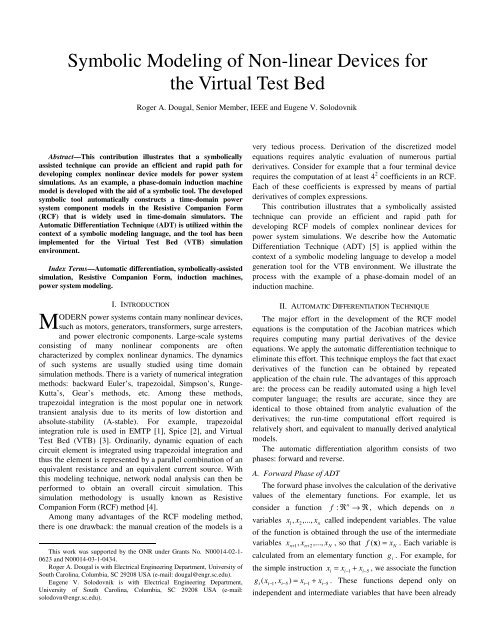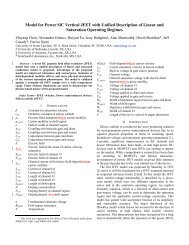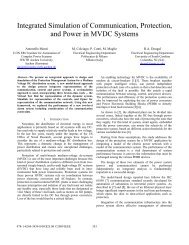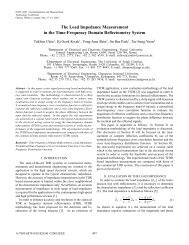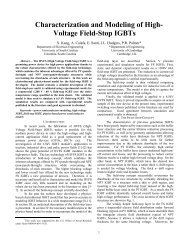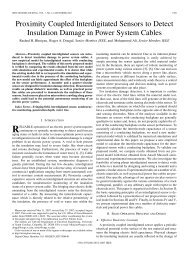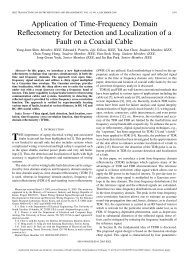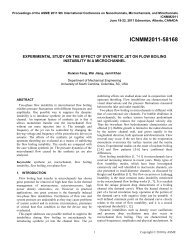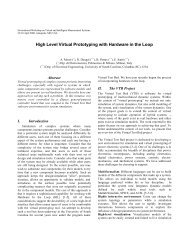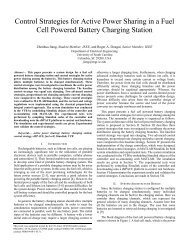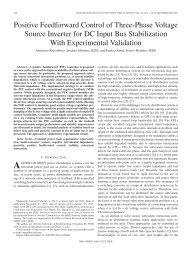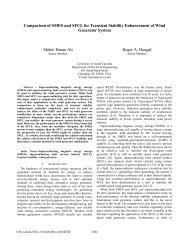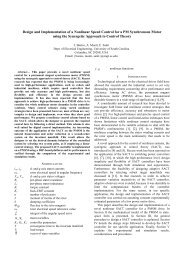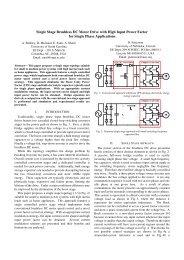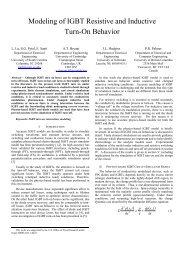Symbolic Modeling of Non-linear Devices for the Virtual Test Bed
Symbolic Modeling of Non-linear Devices for the Virtual Test Bed
Symbolic Modeling of Non-linear Devices for the Virtual Test Bed
Create successful ePaper yourself
Turn your PDF publications into a flip-book with our unique Google optimized e-Paper software.
<strong>Symbolic</strong> <strong>Modeling</strong> <strong>of</strong> <strong>Non</strong>-<strong>linear</strong> <strong>Devices</strong> <strong>for</strong><br />
<strong>the</strong> <strong>Virtual</strong> <strong>Test</strong> <strong>Bed</strong><br />
Roger A. Dougal, Senior Member, IEEE and Eugene V. Solodovnik<br />
Abstract—This contribution illustrates that a symbolically<br />
assisted technique can provide an efficient and rapid path <strong>for</strong><br />
developing complex non<strong>linear</strong> device models <strong>for</strong> power system<br />
simulations. As an example, a phase-domain induction machine<br />
model is developed with <strong>the</strong> aid <strong>of</strong> a symbolic tool. The developed<br />
symbolic tool automatically constructs a time-domain power<br />
system component models in <strong>the</strong> Resistive Companion Form<br />
(RCF) that is widely used in time-domain simulators. The<br />
Automatic Differentiation Technique (ADT) is utilized within <strong>the</strong><br />
context <strong>of</strong> a symbolic modeling language, and <strong>the</strong> tool has been<br />
implemented <strong>for</strong> <strong>the</strong> <strong>Virtual</strong> <strong>Test</strong> <strong>Bed</strong> (VTB) simulation<br />
environment.<br />
Index Terms—Automatic differentiation, symbolically-assisted<br />
simulation, Resistive Companion Form, induction machines,<br />
power system modeling.<br />
I. INTRODUCTION<br />
ODERN power systems contain many non<strong>linear</strong> devices,<br />
M such as motors, generators, trans<strong>for</strong>mers, surge arresters,<br />
and power electronic components. Large-scale systems<br />
consisting <strong>of</strong> many non<strong>linear</strong> components are <strong>of</strong>ten<br />
characterized by complex non<strong>linear</strong> dynamics. The dynamics<br />
<strong>of</strong> such systems are usually studied using time domain<br />
simulation methods. There is a variety <strong>of</strong> numerical integration<br />
methods: backward Euler’s, trapezoidal, Simpson’s, Runge-<br />
Kutta’s, Gear’s methods, etc. Among <strong>the</strong>se methods,<br />
trapezoidal integration is <strong>the</strong> most popular one in network<br />
transient analysis due to its merits <strong>of</strong> low distortion and<br />
absolute-stability (A-stable). For example, trapezoidal<br />
integration rule is used in EMTP [1], Spice [2], and <strong>Virtual</strong><br />
<strong>Test</strong> <strong>Bed</strong> (VTB) [3]. Ordinarily, dynamic equation <strong>of</strong> each<br />
circuit element is integrated using trapezoidal integration and<br />
thus <strong>the</strong> element is represented by a parallel combination <strong>of</strong> an<br />
equivalent resistance and an equivalent current source. With<br />
this modeling technique, network nodal analysis can <strong>the</strong>n be<br />
per<strong>for</strong>med to obtain an overall circuit simulation. This<br />
simulation methodology is usually known as Resistive<br />
Companion Form (RCF) method [4].<br />
Among many advantages <strong>of</strong> <strong>the</strong> RCF modeling method,<br />
<strong>the</strong>re is one drawback: <strong>the</strong> manual creation <strong>of</strong> <strong>the</strong> models is a<br />
This work was supported by <strong>the</strong> ONR under Grants No. N00014-02-1-<br />
0623 and N00014-03-1-0434.<br />
Roger A. Dougal is with Electrical Engineering Department, University <strong>of</strong><br />
South Carolina, Columbia, SC 29208 USA (e-mail: dougal@engr.sc.edu).<br />
Eugene V. Solodovnik is with Electrical Engineering Department,<br />
University <strong>of</strong> South Carolina, Columbia, SC 29208 USA (e-mail:<br />
solodovn@engr.sc.edu).<br />
very tedious process. Derivation <strong>of</strong> <strong>the</strong> discretized model<br />
equations requires analytic evaluation <strong>of</strong> numerous partial<br />
derivatives. Consider <strong>for</strong> example that a four terminal device<br />
requires <strong>the</strong> computation <strong>of</strong> at least 4 2 coefficients in an RCF.<br />
Each <strong>of</strong> <strong>the</strong>se coefficients is expressed by means <strong>of</strong> partial<br />
derivatives <strong>of</strong> complex expressions.<br />
This contribution illustrates that a symbolically assisted<br />
technique can provide an efficient and rapid path <strong>for</strong><br />
developing RCF models <strong>of</strong> complex non<strong>linear</strong> devices <strong>for</strong><br />
power system simulations. We describe how <strong>the</strong> Automatic<br />
Differentiation Technique (ADT) [5] is applied within <strong>the</strong><br />
context <strong>of</strong> a symbolic modeling language to develop a model<br />
generation tool <strong>for</strong> <strong>the</strong> VTB environment. We illustrate <strong>the</strong><br />
process with <strong>the</strong> example <strong>of</strong> a phase-domain model <strong>of</strong> an<br />
induction machine.<br />
II. AUTOMATIC DIFFERENTIATION TECHNIQUE<br />
The major ef<strong>for</strong>t in <strong>the</strong> development <strong>of</strong> <strong>the</strong> RCF model<br />
equations is <strong>the</strong> computation <strong>of</strong> <strong>the</strong> Jacobian matrices which<br />
requires computing many partial derivatives <strong>of</strong> <strong>the</strong> device<br />
equations. We apply <strong>the</strong> automatic differentiation technique to<br />
eliminate this ef<strong>for</strong>t. This technique employs <strong>the</strong> fact that exact<br />
derivatives <strong>of</strong> <strong>the</strong> function can be obtained by repeated<br />
application <strong>of</strong> <strong>the</strong> chain rule. The advantages <strong>of</strong> this approach<br />
are: <strong>the</strong> process can be readily automated using a high level<br />
computer language; <strong>the</strong> results are accurate, since <strong>the</strong>y are<br />
identical to those obtained from analytic evaluation <strong>of</strong> <strong>the</strong><br />
derivatives; <strong>the</strong> run-time computational ef<strong>for</strong>t required is<br />
relatively short, and equivalent to manually derived analytical<br />
models.<br />
The automatic differentiation algorithm consists <strong>of</strong> two<br />
phases: <strong>for</strong>ward and reverse.<br />
A. Forward Phase <strong>of</strong> ADT<br />
The <strong>for</strong>ward phase involves <strong>the</strong> calculation <strong>of</strong> <strong>the</strong> derivative<br />
values <strong>of</strong> <strong>the</strong> elementary functions. For example, let us<br />
consider a function f : R n → R , which depends on n<br />
variables x<br />
1<br />
, x2,...,<br />
xn<br />
called independent variables. The value<br />
<strong>of</strong> <strong>the</strong> function is obtained through <strong>the</strong> use <strong>of</strong> <strong>the</strong> intermediate<br />
variables x<br />
n+ 1<br />
, xn+<br />
2,...,<br />
xN<br />
, so that f (x)<br />
= xN<br />
. Each variable is<br />
calculated from an elementary function g<br />
i<br />
. For example, <strong>for</strong><br />
<strong>the</strong> simple instruction x = +<br />
i<br />
xi− 1<br />
xi−<br />
5<br />
, we associate <strong>the</strong> function<br />
g<br />
i<br />
( xi− 1<br />
, xi−<br />
5)<br />
= xi−<br />
1<br />
+ xi−<br />
5<br />
. These functions depend only on<br />
independent and intermediate variables that have been already
processed. Then, <strong>the</strong> derivatives<br />
g<br />
∂g<br />
i<br />
i, j<br />
= <strong>for</strong> each <strong>of</strong> <strong>the</strong><br />
∂x<br />
j<br />
elementary functions g<br />
i<br />
are determined and stored.<br />
B. Reverse Phase <strong>of</strong> ADT<br />
The reverse phase concludes <strong>the</strong> computation <strong>of</strong> <strong>the</strong><br />
derivatives <strong>of</strong> <strong>the</strong> given function using <strong>the</strong> data obtained at <strong>the</strong><br />
<strong>for</strong>ward phase. The derivative <strong>of</strong> <strong>the</strong> function f (x)<br />
with<br />
respect to <strong>the</strong> variable x k<br />
can be obtained through adding all<br />
<strong>of</strong> <strong>the</strong> products <strong>of</strong> g<br />
i , j<br />
between nodes x<br />
k<br />
and x<br />
N<br />
, i.e.<br />
∂f<br />
(x)<br />
=<br />
∂x<br />
k<br />
∑<br />
∏<br />
g<br />
i,<br />
j<br />
path C arc( i,<br />
j)<br />
∈C<br />
from x k to x N<br />
.<br />
To save time on repetitive calculations, <strong>the</strong> additional<br />
variables<br />
p<br />
k<br />
= ∑ ∏<br />
i j<br />
path C arc( i,<br />
j)<br />
∈C<br />
from xk<br />
to xN<br />
g<br />
,<br />
, 1≤<br />
k ≤ N −1,<br />
pN<br />
= 1<br />
are introduced and <strong>the</strong>n <strong>the</strong> derivatives are computed using<br />
following equations:<br />
p<br />
p<br />
N<br />
k<br />
∂f<br />
∂x<br />
k<br />
= 1<br />
=<br />
N<br />
j=<br />
k+<br />
1<br />
=<br />
∑<br />
N<br />
∑<br />
j=<br />
n+<br />
1<br />
g<br />
j, k<br />
p<br />
j<br />
, n + 1≤<br />
k ≤ N −1. (1)<br />
g<br />
j,<br />
k<br />
p ,<br />
j<br />
1≤<br />
k ≤ n<br />
III. AUTOMATIC GENERATION OF THE RCF MODELS IN VTB<br />
The RCF model generator must create code that implements<br />
two basic functions: <strong>the</strong> initialization function, and <strong>the</strong> time<br />
stepping function. The initialization function is called once at<br />
<strong>the</strong> beginning <strong>of</strong> <strong>the</strong> simulation. The time stepping function is<br />
called repeatedly during <strong>the</strong> simulation. The computationally<br />
intensive parts <strong>of</strong> <strong>the</strong> ADT algorithm are completed during <strong>the</strong><br />
initialization stage. The time stepping part includes only <strong>the</strong><br />
evaluation <strong>of</strong> <strong>the</strong> obtained derivatives (1), ensuring optimal<br />
computational efficiency. The detailed descriptions <strong>of</strong> <strong>the</strong><br />
algorithm can be found in <strong>the</strong> reference [6].<br />
IV. APPLICATION EXAMPLE: DEVELOPMENT OF THE RCF<br />
MODEL OF THE INDUCTION MACHINE<br />
To facilitate <strong>the</strong> development <strong>of</strong> <strong>the</strong> phase-domain RCF<br />
model <strong>of</strong> <strong>the</strong> induction machine [7], <strong>the</strong> model equations <strong>of</strong> <strong>the</strong><br />
machine are manipulated and rearranged according to <strong>the</strong><br />
<strong>for</strong>mat <strong>of</strong> equation (1). The model is highly non<strong>linear</strong> and has<br />
23 equations corresponding to 23 nodes. Thus, <strong>the</strong> Jacobian<br />
matrix <strong>for</strong> this model has 23 2 = 529 elements. Apparently,<br />
manual calculation <strong>of</strong> <strong>the</strong> Jacobian matrix would result in long<br />
development time <strong>of</strong> <strong>the</strong> model and even longer debugging<br />
time, since errors inevitably would be present if <strong>the</strong> RCF<br />
model were to be manually developed by a human. Such<br />
complexity <strong>of</strong> <strong>the</strong> phase-domain model <strong>of</strong> <strong>the</strong> induction<br />
machine is <strong>the</strong> main obstacle to manual development <strong>of</strong> its<br />
RCF representation. However, <strong>the</strong> symbolically assisted model<br />
generator allows <strong>for</strong> rapid development <strong>of</strong> <strong>the</strong> phase-domain<br />
RCF model <strong>of</strong> <strong>the</strong> induction machine. The automatic model<br />
generator ran in just fractions <strong>of</strong> a second and <strong>the</strong> resulting<br />
model was free <strong>of</strong> errors. Fur<strong>the</strong>rmore, computational<br />
efficiency <strong>of</strong> <strong>the</strong> automatically developed RCF model is<br />
comparable to that <strong>of</strong> <strong>the</strong> manually developed model.<br />
To verify <strong>the</strong> new phase-domain RCF model <strong>of</strong> <strong>the</strong><br />
induction machine and demonstrate <strong>the</strong> power <strong>of</strong> <strong>the</strong><br />
developed symbolic model development tool, <strong>the</strong> starting<br />
transients <strong>of</strong> an induction machine are simulated and compared<br />
to <strong>the</strong> results obtained by using a d-q reference model, which<br />
was developed in Matlab. The simulation results obtained from<br />
<strong>the</strong> new phase-domain RCF model in VTB and results from<br />
<strong>the</strong> standard d-q model in Matlab were in good agreement.<br />
V. CONCLUSIONS<br />
The symbolically-assisted tool provides a fast and efficient<br />
way <strong>of</strong> developing complex non<strong>linear</strong> device models. The tool<br />
greatly reduces <strong>the</strong> ef<strong>for</strong>t required to develop a complex<br />
simulation model.<br />
The time-domain model <strong>of</strong> a general induction machine was<br />
rapidly developed with <strong>the</strong> aid <strong>of</strong> a symbolic model<br />
development tool. The resulting model was validated by<br />
comparison to a standard model and was proven suitable <strong>for</strong><br />
power system dynamic simulation.<br />
VI. REFERENCES<br />
[1] Jose R. Marti and Jiming Lin, “Suppression <strong>of</strong> numerical oscillations in<br />
<strong>the</strong> EMTP,” IEEE Trans. on Power Systems, vol. 4, no. 2, pp. 739-747,<br />
May 1989.<br />
[2] K. G. Nichols, T.J. Kazmierski, M. Zwolinski, and A. D. Brow,<br />
“Overview <strong>of</strong> SPICE-like circuit simulation algorithms,” IEE Proc.-<br />
Circuits <strong>Devices</strong> Syst., vol. 141, no. 4, pp. 242-250, Aug. 1994.<br />
[3] R. Dougal, T. Lovett, A. Monti, E. Santi, “A Multilanguage<br />
Environment <strong>for</strong> Interactive Simulation and Development <strong>of</strong> Controls<br />
<strong>for</strong> Power Electronics,” IEEE Power Electronics Specialists Conference,<br />
Vancouver, Canada, June 17-22, 2001.<br />
[4] A. P. Sakis Meliopoulos, G. J. Cokkinides, “A time Domain Model <strong>for</strong><br />
Flicker Analysis,” Proceedings <strong>of</strong> International Conference on Power<br />
System Transients, pp. 365-368, Seattle, WA, Jun. 22-26, 1997.<br />
[5] M. Jerosolimski, L. Levacher, “A New Method For Fast Calculation <strong>of</strong><br />
Jacobian Matrices: Automatic Differentiation For Power System<br />
Simulation,” IEEE Transactions on Power Systems, Vol. 9, No. 2, pp.<br />
700-706, May 1994.<br />
[6] Eugene Solodovnik, George Cokkinides, A.P. Sakis Meliopoulos,<br />
“Utilization <strong>of</strong> Automatic Differentiation in VTB Simulation<br />
Environment”, Proc. <strong>of</strong> 33rd Annual Simulation Symposium,<br />
Washington, DC, April 2000.<br />
[7] Wenzhong Gao and A. P. Sakis Meliopoulos, “Phase-domain model <strong>of</strong> a<br />
three-phase induction machine <strong>for</strong> dynamic simulation,” in Proc. 2001<br />
33rd Annual North American Power Symposium.<br />
VII. BIOGRAPHIES<br />
Roger A. Dougal earned <strong>the</strong> Ph.D. degree in electrical engineering at<br />
Texas Tech University in 1983 and immediately joined <strong>the</strong> faculty at <strong>the</strong>
University <strong>of</strong> South Carolina. Dr. Dougal has received <strong>the</strong> Samuel Litman<br />
Distinguished Pr<strong>of</strong>essor <strong>of</strong> Engineering award, and has been honored as a<br />
Carolina Research Pr<strong>of</strong>essor. He is a Senior Member <strong>of</strong> <strong>the</strong> IEEE. Pr<strong>of</strong>.<br />
Dougal is <strong>the</strong> director <strong>of</strong> <strong>the</strong> <strong>Virtual</strong> <strong>Test</strong> <strong>Bed</strong> project, which is developing an<br />
advanced simulation and virtual prototyping environment <strong>for</strong><br />
multidisciplinary dynamic systems.<br />
Eugene V. Solodovnik obtained <strong>the</strong> E.E. diploma from <strong>the</strong> Taganrog<br />
State University <strong>of</strong> Radio-Engineering, Taganrog, Russia in 1991; <strong>the</strong> Ph.D.<br />
degree from <strong>the</strong> University <strong>of</strong> South Carolina in 2001. Dr. Solodovnik’s<br />
interests include control, modeling, analysis and simulation <strong>of</strong> power systems,<br />
and CAD s<strong>of</strong>tware development.


